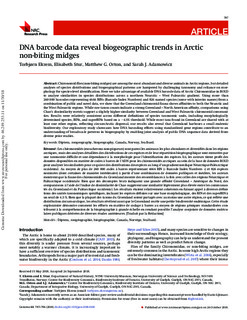DNA barcode data reveal biogeographic trends in Arctic non-biting midges
Journal article, Peer reviewed
Published version

Åpne
Permanent lenke
http://hdl.handle.net/11250/2591210Utgivelsesdato
2018Metadata
Vis full innførselSamlinger
- Institutt for naturhistorie [1240]
- Publikasjoner fra CRIStin - NTNU [38294]
Sammendrag
Chironomid flies (non-biting midges) are among the most abundant and diverse animals in Arctic regions, but detailed analyses of species distributions and biogeographical patterns are hampered by challenging taxonomy and reliance on morphology for species-level identification. Here we take advantage of available DNA barcode data of Arctic Chironomidae in BOLD to analyse similarities in species distributions across a northern Nearctic – West Palearctic gradient. Using more than 260 000 barcodes representing 4666 BINs (Barcode Index Numbers) and 826 named species (some with interim names) from a combination of public and novel data, we show that the Greenland chironomid fauna shows affinities to both the Nearctic and the West Palearctic regions. While raw taxon counts indicate a strong Greenland – North American affinity, comparisons using Chao’s dissimilarity metric support a slightly higher similarity between Greenland and West Palearctic chironomid communities. Results were relatively consistent across different definitions of species taxonomic units, including morphologically determined species, BINs, and superBINs based on a ∼4.5% threshold. While most taxa found in Greenland are shared with at least one other region, reflecting circum-Arctic dispersal, our results also reveal that Greenland harbours a small endemic biodiversity. Our exploratory study showcases how DNA barcoding efforts using standardized gene regions contribute to an understanding of broad-scale patterns in biogeography by enabling joint analysis of public DNA sequence data derived from diverse prior studies.